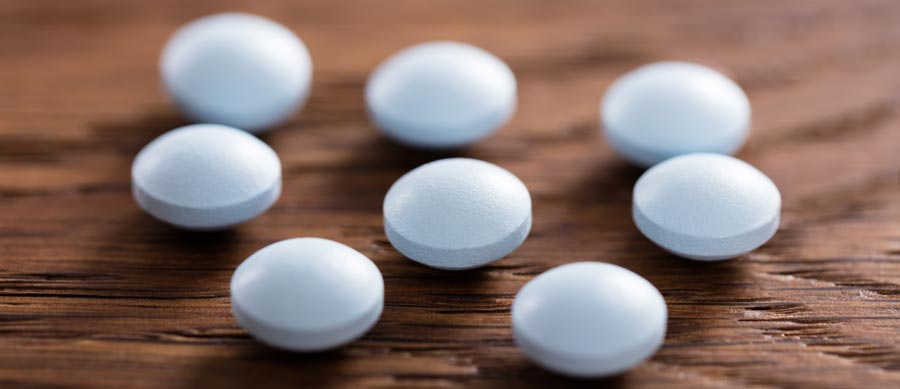Molly (the street name for Ecstasy/MDMA) is a synthetic drug and a party pill that can either be a powder or a pill. It may be a variety of different colors and is typically swallowed, crushed, or snorted. It is a stimulant and a hallucinogen that increases sensory experiences and feelings of empathy and closeness for the user.
Table of contents
In 2017, 1.4 million people ages 12 and over were current users of hallucinogens like Molly. An estimated 1.7 percent of young adults ages 18-25 (594,000 young adults) were current users of hallucinogens.1 Despite the number of teens and young adults that use Molly, it’s an unpredictable synthetic drug that may cause tolerance, addiction, or have life-threatening side-effects.
In this blog, we’ll clear up some of the common misconceptions about Molly so you can understand the real risks and dangers associated with this popular party drug.
1. Using Molly doesn’t harm anyone else.
The immediate effects of Molly are felt by you (the user), but you could also easily put other people’s safety at risk by using it. Although Molly is said to be a “pure” form of Ecstasy or MDMA, the chemical ingredients in any one batch of Molly could vary, producing some very unpredictable side effects and behaviors.2
For example, after using Molly, you may begin behaving irrationally or aggressively, completely lose track of time, or become disoriented and irritable.3 These types of behaviors could cause physical altercations or heated interactions with others. In a social environment like a concert or a party, where emotions are already running high, this type of behavior could cause emotional or physical harm to others.
2. Molly isn’t addictive.
Many people feel like the effects of Molly help them enjoy the music and light at concerts more. It also provides euphoric and energizing effects, so it’s no surprise that it’s often abused in social situations. Although it has a reputation for being a party drug or a “fun” drug that people just do at concerts, festivals, and parties, Molly is, in fact, very dangerous and addictive.
Some of the negative side effects of Molly abuse include:
- Blurred vision
- Nausea
- Mood swings
- Teeth grinding
- Muscle cramping
- Irritability
- Aggression
- Insomnia
- Chills
- Sweating
- Anxiety
- Impulsive behavior
- Reduced appetite4
According to the National Institute on Drug Abuse (NIDA), experts aren’t completely certain whether Molly is addictive or not, although it’s pleasurable effects may cause a person to keep using the drug until they develop a tolerance and become dependent on it. It also increases levels of dopamine in the brain which may reinforce Molly use and abuse.5
After abusing Molly, many users experience a “crash” which is characterized by general feelings of depression and severe emotional withdrawal. These negative feelings may also drive the user to continue using Molly because the feelings associated with the highs are so much more pleasant.
Some Molly users have also reported signs of Molly addiction and withdrawal, including:
- Depression
- Loss of appetite
- Trouble concentrating
- Fatigue
- Anxiety3
According to a 2013 study from the University at Buffalo, 43 percent of young adults and adolescents who use Molly are dependent and 34 percent are abusing the drug.5
3. It’s okay to use Molly to reduce social anxiety in group situations.
Many people use Molly to overcome social anxiety because it creates an artificial sense of empathy for other people and reduces inhibitions.7 Although it may feel easier to engage with other people while under the influence of Molly, abusing the drug for this purpose comes with severe consequences.
For example, people who use Molly are much more likely to behave in seriously risky ways, especially when it comes to sexual behaviors. Many different studies have found that Molly use is highly associated with risky sexual behaviors and both males and females that use Molly are more likely than alcohol users to have unprotected sex. People who use Molly heavily are also more likely to be tested for HIV, although they believe they are less likely to contract the disease.4
The use of Molly is associated with higher rates of risk-taking behaviors in general, and whether that be sexual behaviors or not, is it really worth harming yourself or others?
4. Using Molly is safe as long as you’re careful.
It’s never safe to use any illegal drug, regardless of whether or not you’re careful. However, if a person takes a very large dose of Molly, it can lead to psychosis. While in a psychotic state, a person may experience delusions and hallucinations that cause very strange or dangerous behaviors.
Even a small dose of Molly can cause dangerous effects like panic attacks, fast heartbeat, increased blood pressure, heart attacks, and seizures. Your body may also lose its ability to regulate its temperature, causing fever, severe dehydration, and kidney failure.3
Additionally, any dose of Molly could contain one or several of the following substances, which may cause serious bodily harm and psychological problems:
- Rat poison
- Bath salts
- PCP
- Heroin
- Methamphetamine
- Cocaine
- Household substances2
The point is, using Molly (even just once) can be fatal. The only “safe” and “careful” way to use Molly is to not use it at all.
5. Everyone does it.
The use of Molly has been popularized by music artists like Miley Cyrus, Kanye West, and Madonna in song lyrics, making it more tempting for young people who idolize those stars. The idea that “everyone does it, so it’s okay” is a dangerous one and it’s important that young people are educated on the real risks and dangers of Molly.
Molly Addiction Treatment
Molly addiction treatment, like any other drug addiction, will require physical detox, behavioral therapy, and long-term individual and group 12-step work. At Briarwood Detox Center, our addiction treatment professionals are trained to recognize and treat the symptoms of Molly addiction and withdrawal and can provide effective medical and clinical care in addiction recovery.
Detox for Molly addiction is the first step in a comprehensive addiction treatment program that will help you get sober and stay that way. However, detox alone will not cure you of your addiction. Drug detox for Molly addiction will clear your body of all the toxins and start re-establishing an internal balance. During this process, you’ll also complete the withdrawal process, which may include uncomfortable physical symptoms like sweating, nausea, insomnia, lack of appetite, and mood swings.
Despite the discomfort of Molly withdrawal, a medical detox program at Briarwood will include medical treatment for those issues, so you don’t have to suffer. You’ll be comfortable and safe throughout your entire detox experience.
References:
- https://www.samhsa.gov/data/report/2017-nsduh-annual-national-report
- https://www.thefix.com/content/molly-addiction
- https://www.poison.org/articles/2014-mar/club-drugs-molly
- https://www.drugabuse.gov/publications/research-reports/mdma-ecstasy-abuse/what-are-effects-mdma
- https://www.drugabuse.gov/publications/drugfacts/mdma-ecstasymolly
- http://www.buffalo.edu/ria/news_events/es/es8.html
- https://www.narconon.org/drug-abuse/molly/molly-signs-symptoms.html


